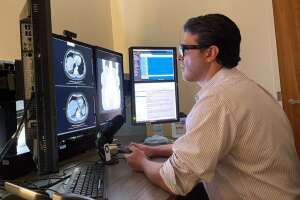by
John R. Fischer, Senior Reporter | December 08, 2023

A new reporting style may reduce time spent dictating and inaccuracies in radiology reports.
A new approach for recording radiology findings with AI-powered speech-to-text conversion tools may decrease dictation time and reduce inaccuracies by improving radiologists’ focus on diagnostic images, compared to the standard checklist reporting style used by these clinicians.
Researchers at Florida International University’s Herbert Wertheim College of Medicine and Baptist Health say their approach is a more concise, but still structured, easy-to-read reporting method whereby radiologists record only the abnormal findings they see. This, they say, reduces time spent correcting mistakes created by the voice software when it misinterprets what clinicians say.
Whereas the standard way of reporting requires radiologists to pay attention to two screens — one showing the images, the other showing transcriptions of spoken findings — with this new style, they are “100% focused on the images,” according to Dr. Ricardo Cury, chair of radiology at both FIU and Baptist Health, who adds that this could potentially allow them to experience fewer feelings of burnout and find managing their workload easier.



Ad Statistics
Times Displayed: 46592
Times Visited: 1410 MIT labs, experts in Multi-Vendor component level repair of: MRI Coils, RF amplifiers, Gradient Amplifiers Contrast Media Injectors. System repairs, sub-assembly repairs, component level repairs, refurbish/calibrate. info@mitlabsusa.com/+1 (305) 470-8013
“You’re going through the checklist in your mind, what you’re trained for. The beauty is you’re only dictating the abnormal findings and only in the end when you’re finished interpreting the findings, you can check the report for accuracy,” said Cury in a statement.
The new reporting approach allows radiologists to focus more on the image rather than dictating the report.
For their study, Cury and his colleagues gave eye-tracking goggles to experienced board-certified radiologists who interpreted 150 X-ray, MR, and CT studies. Of this set, 76 were assessed using the new style, while the other 81 were evaluated using the standard checklist.
On average, the radiologists spent 50% less time dictating findings using the new style, which did not change the total interpretation or examination time.
“The eye-tracking software validated our results because it allowed us to create heatmaps showing that radiologists were directing their attention to the imaging. This is better for the patient, as a heightened focus on the images means that radiologists are dedicating more time to interpreting potential abnormal findings, ultimately improving patient care,” said Mona Roshan, an FIU third-year medical student, and the study’s first author who worked under the guidance of Cury, her mentor.
Cury, Roshan, and the other authors predict that with future advancements in conversational and generative AI, the approach will be able to improve reporting times, overall efficiency in radiology reporting, and accuracy.
Their findings were published in the
European Journal of Radiology.

